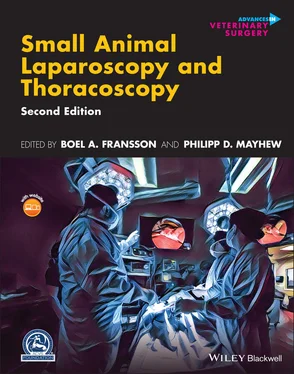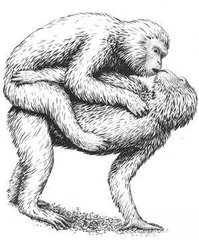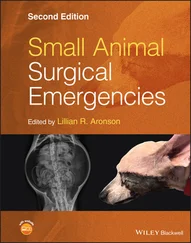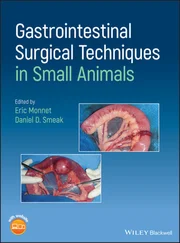This is precisely why the Veterinary Endoscopy Society and this textbook, Small Animal Laparoscopy and Thoracoscopy, are so pivotal. This book elegantly describes all aspects of minimally invasive surgery in small animal patients including instrumentation, fundamental laparoscopic skills, and a deep dive into the most common surgical techniques. The authors found within this book are the who’s who of modern day veterinary surgery, which provides a comprehensive resource to any surgeon from trainee to advanced senior surgeons.
I want to congratulate Drs Fransson and Mayhew on their labor of love in creating an updated version to this must‐have textbook and to their commitment to advancing the field of minimally invasive surgery in small patients.
Todd Ponsky, MD, FACS
Professor of Surgery Director of Clinical Growth and Transformation Cincinnati Children’s Hospital University of Cincinnati, Cincinnati, OH, USA
The American College of Veterinary Surgeons Foundation is excited to present the second edition of Small Animal Laparoscopy and Thoracoscopy in the book series entitled Advances in Veterinary Surgery . In the seven years since the publication of the first edition, the field of minimally invasive surgery has seen tremendous growth. New techniques, equipment, and research have advanced this discipline greatly, making a second edition of the book essential reading for residents in training, as well as surgeons already employing laparoscopy and thoracoscopy in their practices. As one of the key missions of the ACVS Foundation is to promote cutting‐edge education for residents in training and diplomates, this topic is timely and very reflective of the educational mission of the Foundation.
Small Animal Laparoscopy and Thoracoscopy, Second Edition, is edited by Drs Boel Fransson and Philipp Mayhew. I would like to congratulate and thank them for taking on this project. They have chosen an international group of strong contributing authors to cover laparoscopic and thoracoscopic skills, equipment, techniques, and procedures. I am sure you will find this reference extremely valuable.
The ACVS Foundation is an independently charted philanthropic organization. The mission of the ACVS Foundation is to support the advancement of surgical care of all animals through funding of educational and research opportunities for veterinary surgical residents and board‐certified veterinary surgeons.
The ACVS Foundation’s collaboration with Wiley‐Blackwell benefits all those who are interested in veterinary surgery by presenting the latest evidence‐based information on relevant surgical topics. The ACVS Foundation is proud to partner with Wiley‐Blackwell in this important series and is honored to present this newest book in the Advances in Veterinary Surgery series.
R. Randy Basinger, DVM, ACVS
Chair, Board of Trustees
ACVS Foundation
Since the first edition of Small Animal Laparoscopy and Thoracoscopy was published in 2015, many developments have occurred that have propelled veterinary minimally invasive surgery forward. We stated in the preface to that first edition that the textbook was published at the “end of the beginning” of the inception of laparoscopy and thoracoscopy into small animal practice. It might be fair to state six years on, that we are now in the adolescence of the subspecialty. In this time, many new techniques have been developed, large numbers of research papers have been published, and the use of these techniques in both general and specialty practice has blossomed. However, there remains much work to be done to provide the necessary evidence base for these techniques to be widely accepted as the standard of care in our patient population. There is also significant work to be done to improve access to the necessary equipment and training to allow greater patient populations around the world to benefit from the many advantages minimally invasive surgical techniques have to offer our patients. As stated by our foreward author, Dr Todd Ponsky, an eminent pediatric surgeon, who has been extremely magnanimous with his time in support of veterinary minimally invasive surgery, one of the great challenges for our field is to start to engage with medical technology and device companies to create the veterinary species‐specific devices we need to drive the field forward. This challenge was significant for pediatric surgeons and may be one of the significant challenges of the next decade for veterinary minimally invasive surgery. We may also need to work toward a more comprehensive standardized training of all small animal surgery residents and other similar training programs. Thus, we could ensure that the next generations of surgeons are well positioned to continue the work without limitations brought on by lacking fundamental skills.
As the editors of this second edition of the textbook, we have been very aware that the driving force behind the development of veterinary laparoscopy and thoracoscopy is always going to be the thought‐leaders in university teaching hospitals and private practices who relish the challenge of developing new procedures, improving those already in existence and objectively evaluating those currently being performed in practice. We therefore made a conscious effort with this second edition to harness the collective experience and passion of two very important groups. First, those young investigators in the field that represent the future of minimally invasive surgery in veterinary medicine and who are pushing forward the boundaries of what the field will offer patients and owners in the future. Second, we asked the many clinicians and practitioners in far flung corners of the world, who are practicing minimally invasive techniques to bring a truly global perspective to this book. Great breakthroughs in veterinary surgical care are happening in Chile and Japan, in the Netherlands and in Canada and in countless other parts of the globe. This book has contributions from veterinarians all over the world, many of whom are brought together by their common interest and their membership of the Veterinary Endoscopy Society, as well as other societies with an interest in the field. In many countries around the world, local societies dedicated to the improvement of veterinary minimally invasive surgery have now sprung up that will further fuel investigation in the future, and this represents an exciting time to be involved in this subspecialty. On a more personal note, the editors have been hugely gratified by the community that has arisen based on a shared passion to develop minimally invasive surgical interventions for our companion animal species. This has led to the development of many wonderful friendships and many fruitful collaborative relationships that make professional engagement in the field so much more enjoyable.
The chapters in the second edition of this book have been comprehensively updated. The early chapters describe the principals of skills acquisition, minimally invasive suturing, and the latest information on medical technologies and devices used in laparoscopy and thoracoscopy. Subsequent chapters describing anesthetic principals and surgical techniques have been updated with the latest data on the topic, results of recently published research, and lots of tips and tricks from the preeminent experts in the field from around the world. New chapters have also been added covering thoracoscopic anatomy and diagnostic thoracoscopy, laparoscopic hiatal hernia repair, the use of exoscopy in small animal surgery, and natural orifice translumenal surgery. Other chapters have been expanded to describe newly published techniques such as laparoscopic liver resection, retroperitoneal adrenalectomy, and intraoperative cholangiography and laparoscopic common bile duct exploration.
Читать дальше












